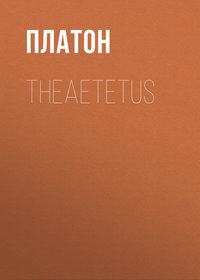 полная версия
полная версияTimaeus
Leaving the further explanation of details, which the reader will find discussed at length in Boeckh and Martin, we may now return to the main argument: Why did God make the world? Like man, he must have a purpose; and his purpose is the diffusion of that goodness or good which he himself is. The term 'goodness' is not to be understood in this passage as meaning benevolence or love, in the Christian sense of the term, but rather law, order, harmony, like the idea of good in the Republic. The ancient mythologers, and even the Hebrew prophets, had spoken of the jealousy of God; and the Greek had imagined that there was a Nemesis always attending the prosperity of mortals. But Plato delights to think of God as the author of order in his works, who, like a father, lives over again in his children, and can never have too much of good or friendship among his creatures. Only, as there is a certain remnant of evil inherent in matter which he cannot get rid of, he detaches himself from them and leaves them to themselves, that he may be guiltless of their faults and sufferings.
Between the ideal and the sensible Plato interposes the two natures of time and space. Time is conceived by him to be only the shadow or image of eternity which ever is and never has been or will be, but is described in a figure only as past or future. This is one of the great thoughts of early philosophy, which are still as difficult to our minds as they were to the early thinkers; or perhaps more difficult, because we more distinctly see the consequences which are involved in such an hypothesis. All the objections which may be urged against Kant's doctrine of the ideality of space and time at once press upon us. If time is unreal, then all which is contained in time is unreal – the succession of human thoughts as well as the flux of sensations; there is no connecting link between (Greek) and (Greek). Yet, on the other hand, we are conscious that knowledge is independent of time, that truth is not a thing of yesterday or tomorrow, but an 'eternal now.' To the 'spectator of all time and all existence' the universe remains at rest. The truths of geometry and arithmetic in all their combinations are always the same. The generations of men, like the leaves of the forest, come and go, but the mathematical laws by which the world is governed remain, and seem as if they could never change. The ever-present image of space is transferred to time – succession is conceived as extension. (We remark that Plato does away with the above and below in space, as he has done away with the absolute existence of past and future.) The course of time, unless regularly marked by divisions of number, partakes of the indefiniteness of the Heraclitean flux. By such reflections we may conceive the Greek to have attained the metaphysical conception of eternity, which to the Hebrew was gained by meditation on the Divine Being. No one saw that this objective was really a subjective, and involved the subjectivity of all knowledge. 'Non in tempore sed cum tempore finxit Deus mundum,' says St. Augustine, repeating a thought derived from the Timaeus, but apparently unconscious of the results to which his doctrine would have led.
The contradictions involved in the conception of time or motion, like the infinitesimal in space, were a source of perplexity to the mind of the Greek, who was driven to find a point of view above or beyond them. They had sprung up in the decline of the Eleatic philosophy and were very familiar to Plato, as we gather from the Parmenides. The consciousness of them had led the great Eleatic philosopher to describe the nature of God or Being under negatives. He sings of 'Being unbegotten and imperishable, unmoved and never-ending, which never was nor will be, but always is, one and continuous, which cannot spring from any other; for it cannot be said or imagined not to be.' The idea of eternity was for a great part a negation. There are regions of speculation in which the negative is hardly separable from the positive, and even seems to pass into it. Not only Buddhism, but Greek as well as Christian philosophy, show that it is quite possible that the human mind should retain an enthusiasm for mere negations. In different ages and countries there have been forms of light in which nothing could be discerned and which have nevertheless exercised a life-giving and illumining power. For the higher intelligence of man seems to require, not only something above sense, but above knowledge, which can only be described as Mind or Being or Truth or God or the unchangeable and eternal element, in the expression of which all predicates fail and fall short. Eternity or the eternal is not merely the unlimited in time but the truest of all Being, the most real of all realities, the most certain of all knowledge, which we nevertheless only see through a glass darkly. The passionate earnestness of Parmenides contrasts with the vacuity of the thought which he is revolving in his mind.
Space is said by Plato to be the 'containing vessel or nurse of generation.' Reflecting on the simplest kinds of external objects, which to the ancients were the four elements, he was led to a more general notion of a substance, more or less like themselves, out of which they were fashioned. He would not have them too precisely distinguished. Thus seems to have arisen the first dim perception of (Greek) or matter, which has played so great a part in the metaphysical philosophy of Aristotle and his followers. But besides the material out of which the elements are made, there is also a space in which they are contained. There arises thus a second nature which the senses are incapable of discerning and which can hardly be referred to the intelligible class. For it is and it is not, it is nowhere when filled, it is nothing when empty. Hence it is said to be discerned by a kind of spurious or analogous reason, partaking so feebly of existence as to be hardly perceivable, yet always reappearing as the containing mother or nurse of all things. It had not that sort of consistency to Plato which has been given to it in modern times by geometry and metaphysics. Neither of the Greek words by which it is described are so purely abstract as the English word 'space' or the Latin 'spatium.' Neither Plato nor any other Greek would have spoken of (Greek) or (Greek) in the same manner as we speak of 'time' and 'space.'
Yet space is also of a very permanent or even eternal nature; and Plato seems more willing to admit of the unreality of time than of the unreality of space; because, as he says, all things must necessarily exist in space. We, on the other hand, are disposed to fancy that even if space were annihilated time might still survive. He admits indeed that our knowledge of space is of a dreamy kind, and is given by a spurious reason without the help of sense. (Compare the hypotheses and images of Rep.) It is true that it does not attain to the clearness of ideas. But like them it seems to remain, even if all the objects contained in it are supposed to have vanished away. Hence it was natural for Plato to conceive of it as eternal. We must remember further that in his attempt to realize either space or matter the two abstract ideas of weight and extension, which are familiar to us, had never passed before his mind.
Thus far God, working according to an eternal pattern, out of his goodness has created the same, the other, and the essence (compare the three principles of the Philebus – the finite, the infinite, and the union of the two), and out of them has formed the outer circle of the fixed stars and the inner circle of the planets, divided according to certain musical intervals; he has also created time, the moving image of eternity, and space, existing by a sort of necessity and hardly distinguishable from matter. The matter out of which the world is formed is not absolutely void, but retains in the chaos certain germs or traces of the elements. These Plato, like Empedocles, supposed to be four in number – fire, air, earth, and water. They were at first mixed together; but already in the chaos, before God fashioned them by form and number, the greater masses of the elements had an appointed place. Into the confusion (Greek) which preceded Plato does not attempt further to penetrate. They are called elements, but they are so far from being elements (Greek) or letters in the higher sense that they are not even syllables or first compounds. The real elements are two triangles, the rectangular isosceles which has but one form, and the most beautiful of the many forms of scalene, which is half of an equilateral triangle. By the combination of these triangles which exist in an infinite variety of sizes, the surfaces of the four elements are constructed.
That there were only five regular solids was already known to the ancients, and out of the surfaces which he has formed Plato proceeds to generate the four first of the five. He perhaps forgets that he is only putting together surfaces and has not provided for their transformation into solids. The first solid is a regular pyramid, of which the base and sides are formed by four equilateral or twenty-four scalene triangles. Each of the four solid angles in this figure is a little larger than the largest of obtuse angles. The second solid is composed of the same triangles, which unite as eight equilateral triangles, and make one solid angle out of four plane angles – six of these angles form a regular octahedron. The third solid is a regular icosahedron, having twenty triangular equilateral bases, and therefore 120 rectangular scalene triangles. The fourth regular solid, or cube, is formed by the combination of four isosceles triangles into one square and of six squares into a cube. The fifth regular solid, or dodecahedron, cannot be formed by a combination of either of these triangles, but each of its faces may be regarded as composed of thirty triangles of another kind. Probably Plato notices this as the only remaining regular polyhedron, which from its approximation to a globe, and possibly because, as Plutarch remarks, it is composed of 12 x 30 = 360 scalene triangles (Platon. Quaest.), representing thus the signs and degrees of the Zodiac, as well as the months and days of the year, God may be said to have 'used in the delineation of the universe.' According to Plato earth was composed of cubes, fire of regular pyramids, air of regular octahedrons, water of regular icosahedrons. The stability of the last three increases with the number of their sides.
The elements are supposed to pass into one another, but we must remember that these transformations are not the transformations of real solids, but of imaginary geometrical figures; in other words, we are composing and decomposing the faces of substances and not the substances themselves – it is a house of cards which we are pulling to pieces and putting together again (compare however Laws). Yet perhaps Plato may regard these sides or faces as only the forms which are impressed on pre-existent matter. It is remarkable that he should speak of each of these solids as a possible world in itself, though upon the whole he inclines to the opinion that they form one world and not five. To suppose that there is an infinite number of worlds, as Democritus (Hippolyt. Ref. Haer. I.) had said, would be, as he satirically observes, 'the characteristic of a very indefinite and ignorant mind.'
The twenty triangular faces of an icosahedron form the faces or sides of two regular octahedrons and of a regular pyramid (20 = 8 x 2 + 4); and therefore, according to Plato, a particle of water when decomposed is supposed to give two particles of air and one of fire. So because an octahedron gives the sides of two pyramids (8 = 4 x 2), a particle of air is resolved into two particles of fire.
The transformation is effected by the superior power or number of the conquering elements. The manner of the change is (1) a separation of portions of the elements from the masses in which they are collected; (2) a resolution of them into their original triangles; and (3) a reunion of them in new forms. Plato himself proposes the question, Why does motion continue at all when the elements are settled in their places? He answers that although the force of attraction is continually drawing similar elements to the same spot, still the revolution of the universe exercises a condensing power, and thrusts them again out of their natural places. Thus want of uniformity, the condition of motion, is produced. In all such disturbances of matter there is an alternative for the weaker element: it may escape to its kindred, or take the form of the stronger – becoming denser, if it be denser, or rarer if rarer. This is true of fire, air, and water, which, being composed of similar triangles, are interchangeable; earth, however, which has triangles peculiar to itself, is capable of dissolution, but not of change. Of the interchangeable elements, fire, the rarest, can only become a denser, and water, the densest, only a rarer: but air may become a denser or a rarer. No single particle of the elements is visible, but only the aggregates of them are seen. The subordinate species depend, not upon differences of form in the original triangles, but upon differences of size. The obvious physical phenomena from which Plato has gathered his views of the relations of the elements seem to be the effect of fire upon air, water, and earth, and the effect of water upon earth. The particles are supposed by him to be in a perpetual process of circulation caused by inequality. This process of circulation does not admit of a vacuum, as he tells us in his strange account of respiration.
Of the phenomena of light and heavy he speaks afterwards, when treating of sensation, but they may be more conveniently considered by us in this place. They are not, he says, to be explained by 'above' and 'below,' which in the universal globe have no existence, but by the attraction of similars towards the great masses of similar substances; fire to fire, air to air, water to water, earth to earth. Plato's doctrine of attraction implies not only (1) the attraction of similar elements to one another, but also (2) of smaller bodies to larger ones. Had he confined himself to the latter he would have arrived, though, perhaps, without any further result or any sense of the greatness of the discovery, at the modern doctrine of gravitation. He does not observe that water has an equal tendency towards both water and earth. So easily did the most obvious facts which were inconsistent with his theories escape him.
The general physical doctrines of the Timaeus may be summed up as follows: (1) Plato supposes the greater masses of the elements to have been already settled in their places at the creation: (2) they are four in number, and are formed of rectangular triangles variously combined into regular solid figures: (3) three of them, fire, air, and water, admit of transformation into one another; the fourth, earth, cannot be similarly transformed: (4) different sizes of the same triangles form the lesser species of each element: (5) there is an attraction of like to like – smaller masses of the same kind being drawn towards greater: (6) there is no void, but the particles of matter are ever pushing one another round and round (Greek). Like the atomists, Plato attributes the differences between the elements to differences in geometrical figures. But he does not explain the process by which surfaces become solids; and he characteristically ridicules Democritus for not seeing that the worlds are finite and not infinite.
Section 4
The astronomy of Plato is based on the two principles of the same and the other, which God combined in the creation of the world. The soul, which is compounded of the same, the other, and the essence, is diffused from the centre to the circumference of the heavens. We speak of a soul of the universe; but more truly regarded, the universe of the Timaeus is a soul, governed by mind, and holding in solution a residuum of matter or evil, which the author of the world is unable to expel, and of which Plato cannot tell us the origin. The creation, in Plato's sense, is really the creation of order; and the first step in giving order is the division of the heavens into an inner and outer circle of the other and the same, of the divisible and the indivisible, answering to the two spheres, of the planets and of the world beyond them, all together moving around the earth, which is their centre. To us there is a difficulty in apprehending how that which is at rest can also be in motion, or that which is indivisible exist in space. But the whole description is so ideal and imaginative, that we can hardly venture to attribute to many of Plato's words in the Timaeus any more meaning than to his mythical account of the heavens in the Republic and in the Phaedrus. (Compare his denial of the 'blasphemous opinion' that there are planets or wandering stars; all alike move in circles – Laws.) The stars are the habitations of the souls of men, from which they come and to which they return. In attributing to the fixed stars only the most perfect motion – that which is on the same spot or circulating around the same – he might perhaps have said that to 'the spectator of all time and all existence,' to borrow once more his own grand expression, or viewed, in the language of Spinoza, 'sub specie aeternitatis,' they were still at rest, but appeared to move in order to teach men the periods of time. Although absolutely in motion, they are relatively at rest; or we may conceive of them as resting, while the space in which they are contained, or the whole anima mundi, revolves.
The universe revolves around a centre once in twenty-four hours, but the orbits of the fixed stars take a different direction from those of the planets. The outer and the inner sphere cross one another and meet again at a point opposite to that of their first contact; the first moving in a circle from left to right along the side of a parallelogram which is supposed to be inscribed in it, the second also moving in a circle along the diagonal of the same parallelogram from right to left; or, in other words, the first describing the path of the equator, the second, the path of the ecliptic. The motion of the second is controlled by the first, and hence the oblique line in which the planets are supposed to move becomes a spiral. The motion of the same is said to be undivided, whereas the inner motion is split into seven unequal orbits – the intervals between them being in the ratio of two and three, three of either: – the Sun, moving in the opposite direction to Mercury and Venus, but with equal swiftness; the remaining four, Moon, Saturn, Mars, Jupiter, with unequal swiftness to the former three and to one another. Thus arises the following progression: – Moon 1, Sun 2, Venus 3, Mercury 4, Mars 8, Jupiter 9, Saturn 27. This series of numbers is the compound of the two Pythagorean ratios, having the same intervals, though not in the same order, as the mixture which was originally divided in forming the soul of the world.
Plato was struck by the phenomenon of Mercury, Venus, and the Sun appearing to overtake and be overtaken by one another. The true reason of this, namely, that they lie within the circle of the earth's orbit, was unknown to him, and the reason which he gives – that the two former move in an opposite direction to the latter – is far from explaining the appearance of them in the heavens. All the planets, including the sun, are carried round in the daily motion of the circle of the fixed stars, and they have a second or oblique motion which gives the explanation of the different lengths of the sun's course in different parts of the earth. The fixed stars have also two movements – a forward movement in their orbit which is common to the whole circle; and a movement on the same spot around an axis, which Plato calls the movement of thought about the same. In this latter respect they are more perfect than the wandering stars, as Plato himself terms them in the Timaeus, although in the Laws he condemns the appellation as blasphemous.
The revolution of the world around earth, which is accomplished in a single day and night, is described as being the most perfect or intelligent. Yet Plato also speaks of an 'annus magnus' or cyclical year, in which periods wonderful for their complexity are found to coincide in a perfect number, i.e. a number which equals the sum of its factors, as 6 = 1 + 2 + 3. This, although not literally contradictory, is in spirit irreconcilable with the perfect revolution of twenty-four hours. The same remark may be applied to the complexity of the appearances and occultations of the stars, which, if the outer heaven is supposed to be moving around the centre once in twenty-four hours, must be confined to the effects produced by the seven planets. Plato seems to confuse the actual observation of the heavens with his desire to find in them mathematical perfection. The same spirit is carried yet further by him in the passage already quoted from the Laws, in which he affirms their wanderings to be an appearance only, which a little knowledge of mathematics would enable men to correct.
We have now to consider the much discussed question of the rotation or immobility of the earth. Plato's doctrine on this subject is contained in the following words: – 'The earth, which is our nurse, compacted (OR revolving) around the pole which is extended through the universe, he made to be the guardian and artificer of night and day, first and eldest of gods that are in the interior of heaven'. There is an unfortunate doubt in this passage (1) about the meaning of the word (Greek), which is translated either 'compacted' or 'revolving,' and is equally capable of both explanations. A doubt (2) may also be raised as to whether the words 'artificer of day and night' are consistent with the mere passive causation of them, produced by the immobility of the earth in the midst of the circling universe. We must admit, further, (3) that Aristotle attributed to Plato the doctrine of the rotation of the earth on its axis. On the other hand it has been urged that if the earth goes round with the outer heaven and sun in twenty-four hours, there is no way of accounting for the alternation of day and night; since the equal motion of the earth and sun would have the effect of absolute immobility. To which it may be replied that Plato never says that the earth goes round with the outer heaven and sun; although the whole question depends on the relation of earth and sun, their movements are nowhere precisely described. But if we suppose, with Mr. Grote, that the diurnal rotation of the earth on its axis and the revolution of the sun and outer heaven precisely coincide, it would be difficult to imagine that Plato was unaware of the consequence. For though he was ignorant of many things which are familiar to us, and often confused in his ideas where we have become clear, we have no right to attribute to him a childish want of reasoning about very simple facts, or an inability to understand the necessary and obvious deductions from geometrical figures or movements. Of the causes of day and night the pre-Socratic philosophers, and especially the Pythagoreans, gave various accounts, and therefore the question can hardly be imagined to have escaped him. On the other hand it may be urged that the further step, however simple and obvious, is just what Plato often seems to be ignorant of, and that as there is no limit to his insight, there is also no limit to the blindness which sometimes obscures his intelligence (compare the construction of solids out of surfaces in his account of the creation of the world, or the attraction of similars to similars). Further, Mr. Grote supposes, not that (Greek) means 'revolving,' or that this is the sense in which Aristotle understood the word, but that the rotation of the earth is necessarily implied in its adherence to the cosmical axis. But (a) if, as Mr Grote assumes, Plato did not see that the rotation of the earth on its axis and of the sun and outer heavens around the earth in equal times was inconsistent with the alternation of day and night, neither need we suppose that he would have seen the immobility of the earth to be inconsistent with the rotation of the axis. And (b) what proof is there that the axis of the world revolves at all? (c) The comparison of the two passages quoted by Mr Grote (see his pamphlet on 'The Rotation of the Earth') from Aristotle De Coelo, Book II (Greek) clearly shows, although this is a matter of minor importance, that Aristotle, as Proclus and Simplicius supposed, understood (Greek) in the Timaeus to mean 'revolving.' For the second passage, in which motion on an axis is expressly mentioned, refers to the first, but this would be unmeaning unless (Greek) in the first passage meant rotation on an axis. (4) The immobility of the earth is more in accordance with Plato's other writings than the opposite hypothesis. For in the Phaedo the earth is described as the centre of the world, and is not said to be in motion. In the Republic the pilgrims appear to be looking out from the earth upon the motions of the heavenly bodies; in the Phaedrus, Hestia, who remains immovable in the house of Zeus while the other gods go in procession, is called the first and eldest of the gods, and is probably the symbol of the earth. The silence of Plato in these and in some other passages (Laws) in which he might be expected to speak of the rotation of the earth, is more favourable to the doctrine of its immobility than to the opposite. If he had meant to say that the earth revolves on its axis, he would have said so in distinct words, and have explained the relation of its movements to those of the other heavenly bodies. (5) The meaning of the words 'artificer of day and night' is literally true according to Plato's view. For the alternation of day and night is not produced by the motion of the heavens alone, or by the immobility of the earth alone, but by both together; and that which has the inherent force or energy to remain at rest when all other bodies are moving, may be truly said to act, equally with them. (6) We should not lay too much stress on Aristotle or the writer De Caelo having adopted the other interpretation of the words, although Alexander of Aphrodisias thinks that he could not have been ignorant either of the doctrine of Plato or of the sense which he intended to give to the word (Greek). For the citations of Plato in Aristotle are frequently misinterpreted by him; and he seems hardly ever to have had in his mind the connection in which they occur. In this instance the allusion is very slight, and there is no reason to suppose that the diurnal revolution of the heavens was present to his mind. Hence we need not attribute to him the error from which we are defending Plato.











